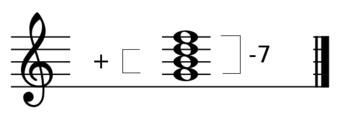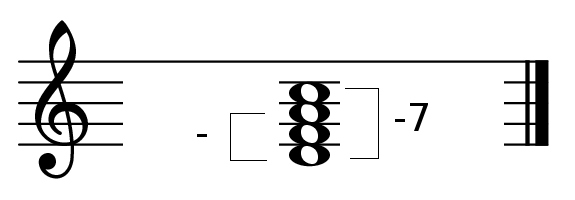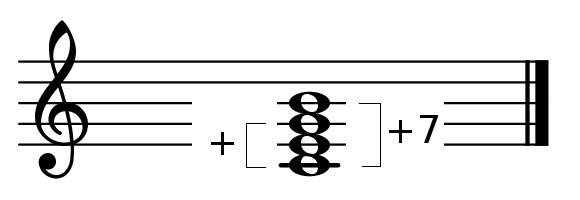Once we are reasonably comfortable with intervals and triads, we can start to work on seventh chords. You may recall that a seventh chord is a triad with an added seventh above the root. The most common seventh chord in western music is the dominant seventh chord.
Dominant Seventh Chords
In C major the dominant seventh pitches are G B D F, G to F being the seventh:
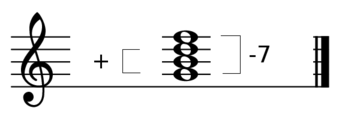
Dominant Seventh Chord
This chord is a major triad built on V with a minor seventh above the root. Its solfege is so ti re fa. First we will learn how to sing it.
- Sing a major scale ascending and descending.
- Continue down from do to so: do ti la so.
- Sing so to so: so la ti do re mi fa so.
- Now try singing just the dominant seventh chord: so ti re fa.
As before, we will continue to work on this chord by listening to it and singing it back. Here are four different dominant sevenths for you to practice with. You can pause the playback if you need more time between the chords. You could also create your own examples at your instrument:

Dominant Seventh Chords – so ti re fa
As with triads, we should also try to pull the pitches out of block chords. Following are four dominant sevenths in closed voicing. Try to sing each one from the root through to the seventh after listening to it:

Dominant Seventh Block Chords
We can also work on the chord in open voicing. Here we are trying to reduce the open voicing to a closed voicing by singing through the chord as in the previous exercise:
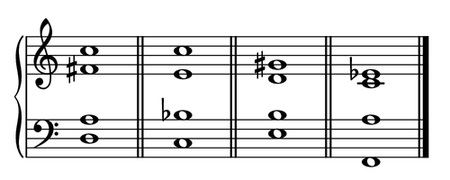
Dominant Sevenths – Open Voicing
Minor Seventh Chords
Once you are comfortable with dominant sevenths we can add in minor seventh chords, the next most common seventh chord. It consists of a minor triad with a minor seventh above the root:
In classical music we often find this chord built on II and used as a predominant chord. Its solfege is re fa la do. You could also use an alternate solfege based on the natural minor scale: la do mi so.
The next two examples are similar to the ones used for the dominant seventh chords to help you get started. First a series of minor seventh chord arpeggios for you to sing back:

Minor Seventh Chords – re fa la do
Now a few examples as block chords:

Minor Seventh Block Chords
Comparison
Before moving on to the next seventh chord types, we should spend a little time comparing dominant sevenths and minor sevenths. If we look at a C dominant seventh chord and a C minor seventh chord, the only difference in pitch is the E-natural/E-flat:

Dominant/Minor Seventh Comparison
Nevertheless their sound qualities are substantially different. As we already know, a dominant seventh is built on major triad while, the minor seventh chord is based on a minor triad. Another contributing factor to their difference in sound is that the dominant seventh contains the interval of a tritone between the third and seventh of the chord, a fairly spicy interval. The strongest sounding interval in the minor seventh chord is the minor seventh itself between the C and B-flat in the above example.
We can summarize the interval content of dominant seventh chords as having a major third, two minor thirds, a perfect fifth, a diminished fifth, and a minor seventh. The minor seventh chord is almost exactly the same. The only difference is that it contains two perfect fifths and no tritones. This information will be useful to us when we add in other seventh chord types, as well as inversions.
This example contains a series of dominant and minor seventh chords for you to try and identify.
Major Seventh Chords
The next seventh chord on our list to learn is the major seventh chord: a major triad with an added major seventh above the root. Its simplest solfege is on the tonic: do mi so ti. It has a nice open sound.
As before, you will have two exercises to get you started: one that arpeggiates through several major seventh chords, and one with them as block chords:

Major Seventh Chords – do mi so ti

Major Seventh Block Chords
Half-Diminished and Diminished Seventh Chords
The remaining seventh chords are the half diminished seventh chord and the diminished seventh chord. The half diminished seventh chord can be built on the seventh scale degree of a major scale. Its solfege is ti re fa la. Its basic structure is a diminished triad plus a minor seventh:
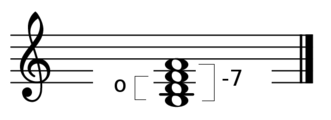
Half Diminished Seventh Chord
The diminished seventh chord is built on the seventh scale degree of the harmonic minor scale: si ti re fa. This chord is built out of a diminished triad with an added diminished seventh:
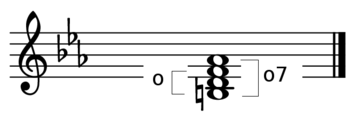
Diminished Seventh Chord
You may wish to use an alternate solfege that will help you compare it to the half diminished triad: ti re fa les. Here we are singing the half diminished triad and flattening the seventh:
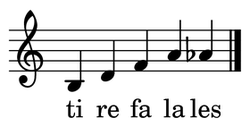
Diminished Seventh Chord (alternative solfege)
Study Plan
The five different seventh chords presented in this article are the main ones found in classical theory. Jazz and popular styles identify other types, but these ones are probably more than enough for now! At this point in this series of articles it may be useful to think a little bit about a study plan.
So far we have presented scales, intervals, triads (Pt. 1, Pt. 2) and seventh chords as musical elements that musicians can learn to identify. It will probably take some time to accomplish this task, but you can work on on these four areas at the same time. Continue to read and try the exercises that follow in this series, but limit yourself to the following items for a while until you are comfortable with them:
- Major and minor scales
- Melodic intervals up to the perfect fifth
- Major and minor triads
- Dominant seventh, and minor seventh chords
Later, add in the remaining intervals and triad types, and finally the rest of the seventh chords.
Remember to take training at your own pace, and focus on the basics before introducing more complex elements. You might want to re-read the series from the start to remind yourself. Come talk to us in the forums to get help if you’re having any problems.
The series continues with Hearing Chord Inversions…

